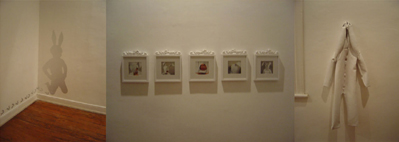|
CATALINA SCHLIEBENER
(Santiago, Chile)
|
PART2:
Catalina Schlievener and the post-human body
|
Presenta
/ Presenterar
ALEXANDER
DEL RE
Artista performático, director de Perfopuerto
Performancekonstnär, Curator för Perforpuerto
|
|
|
|
Catalina Schliebener,
is a young chilean visual artist whose work deals with children,
her preferred subjects, in a post-human fashion.
In most of her work, she is addressing the use of children in
outdated advertising as oppossed to the human body as flesh; child
models are represented in digital imagery in conjuction with the
display of body parts.
For her installation of “Odiosa”, 2003, she dressed
a child model in a bunny outfit, then she documented the process
of the child while playing, exploring, and then getting bored
of “being a bunny”. The installation displays a set
of digital photography of the child dressed as bunny, next to
the real bunny outfit, and the repetition of the bunny theme all
over the gallery room. The performative factor here is implicit
in the exhibition of the documentation and the treatment of the
dress as the outcome of the actions.
In her recent installation, “Boutique”, in 2004, she
focused her attention on child “freaks”, and the ambivalent
exposition of phenomena and children.
For the exhibition, she combines a picture of real siamese twins
with a set of backlight displays of real child clothing for fictitious
siamese twins.
Her work addresses the civilization at large, its contradictions
and conflicts are visible by exposing
its heirs: the children, both from the present and past, beautiful
and ugly. Her child subjects are often with no specific or fixed
“identity”, there is a loss of the “real subject”:
the body only acts as a post-human metaphor.
Her space use is confrontational with the viewer, the spectator
is not free to decide: her compelling images leave no room for
an escape.
|
|
|
|
Catalina
Schliebener, es una jóven artista visual chilena cuyo
trabajo trata acerca de los niños, sus sujetos preferidos,
de una manera post-humana.
En la mayor parte de su trabajo, ella trata del uso de los niños
en los anuncios publicitarios pasados de moda por oposición
al cuerpo humano como carne; modelos infantiles son representados
en forma de imágenes digitales en conjunto con la presentación
de partes del cuerpo.
Para su instalación ”Odiosa” (arriba y abajo),
vistió a un modelo infantil con un disfráz de
conejo, luego documentó el proceso del niño jugando,
explorando, y por último, aburriéndose de ”ser
un conejo”. La instalación muesta un conjunto de
fotografías digitales del niño vestido de conejo,
al lado del disfraz de conejo real, y la repetición del
tema del conejo por toda la sala de la galería. El factor
performance está implícito en la exibición
de la documentación y del tratamiento del disfráz
como resultado de las acciones.
En su reciente instalación, ”Boutique”, de
2004, ella concentró su atención sobre los niños
”monstruitos”, y la ambivalente exposición
de fenómenos y niños.
Para
la exposición, ella combina la imagen de mellizos siameses
reales con un juego de retroproyecciones de ropas infantiles
reales para mellizos siameses imaginarios.
Su trabajo trata acerca de la civilización en su conjunto,
sus contradicciones y conflictos se hacen visibles al exponer
a sus herederos: los niños, tanto del presente como del
pasado, bellos y feos. Sus sujetos infantiles carecen a menudo
de una ”identidad” específica o fija, hay una
pérdida del ”sujeto real”: el cuerpo sólo
actúa como una metáfora post-humana.
Su uso del espacio es confrontativo con respecto al espectador,
éste no es libre para decidir: sus imágenes compulsivas
no dejan espacio para la huída.
|
|
ODIOSA:
Performance, 2003
|
 |
|
|
|
|
BOUTIQUE
2004
|
|
|